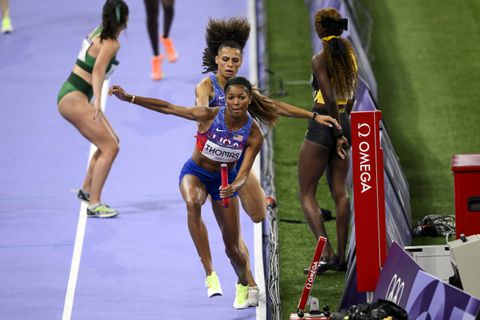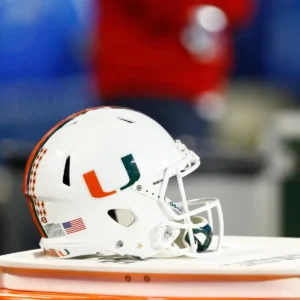
Gabby Thomas and Sydney McLaughlin-Levrone, two of the most electrifying sprinters on Team USA, are widely known for their incredible speed, power, and precision on the track. But during the Olympics, even the best athletes can encounter tense, high-stakes moments that test their composure and teamwork. One such moment occurred between Thomas and McLaughlin-Levrone during a baton exchange in a relay race—a point where a single misstep could spell disaster for their team. In a recent interview, Thomas opened up about that high-stakes exchange and how close they came to a major mishap that could have cost Team USA a podium finish.
Gabby Thomas, known for her speed and powerful finishes in the 200 meters, has been a consistent force in track and field, earning medals and breaking records with a cool, calm demeanor. Meanwhile, Sydney McLaughlin-Levrone, a phenom in her own right, gained fame as the world-record holder in the 400-meter hurdles and a multi-time gold medalist. Their combined experience and chemistry made them a formidable duo in relays, but as Thomas explained, even the most seasoned athletes can face unexpected challenges when racing on the world’s biggest stage.
### The Pressure of the Olympics and Relay Dynamics
The Olympics amplify every aspect of an athlete’s performance, putting immense pressure on each team member. Relays require coordination, speed, and trust in teammates, and the baton exchange is where it all culminates. One wrong move, one mistimed handoff, and a team’s medal hopes can vanish in seconds. For Thomas and McLaughlin-Levrone, who had trained together and knew each other’s strengths, the exchange should have been seamless, but as Thomas revealed, things nearly went off track.
In a relay race, the baton exchange zone is where athletes must execute their handoff within a limited distance, typically around 20 meters. This zone is rigidly enforced, and if the exchange occurs outside of it, the team can be disqualified. This regulation adds an extra layer of intensity to the exchange. Both Thomas and McLaughlin-Levrone understood the stakes, and they had practiced the handoff countless times in preparation. But on that particular day, something unexpected happened.
### The Close Call: Gabby Thomas’ Perspective
In her account, Thomas described how she felt the energy and pressure building as she approached McLaughlin-Levrone in the exchange zone. Thomas, who has a natural acceleration, began her sprint with the baton, closing in on the designated handoff area. She was well within her rhythm, but as she extended her hand, she sensed the baton exchange was not as smooth as usual. Thomas said she could feel a slight hesitation from McLaughlin-Levrone, who was already preparing to surge ahead as soon as she had the baton firmly in hand.
Thomas recounted that there was a split second when she thought, “This could go wrong.” She noticed McLaughlin-Levrone wasn’t quite in sync, likely due to the energy and noise of the packed stadium. The intensity of the moment, coupled with the deafening cheers from the crowd, made communication difficult. Thomas explained that in a split-second decision, she tightened her grip and adjusted her pace slightly, hoping McLaughlin-Levrone would catch on and get into position to receive the baton securely.
This slight adjustment was a risky move, but it paid off. McLaughlin-Levrone felt the extra moment Thomas took and adjusted her own timing, allowing her to secure the baton just within the exchange zone. “I knew we couldn’t afford a fumble or an out-of-zone exchange,” Thomas said. “So I held on for just a heartbeat longer than usual, and I’m glad Sydney caught it in time.”
### Sydney McLaughlin-Levrone’s Side of the Story
Though Thomas initially shared her perspective, McLaughlin-Levrone later added her own experience of that close call. She admitted she had been so focused on getting her start right that she momentarily misjudged the timing, almost missing Thomas’s approach. When she saw Thomas holding the baton slightly longer, McLaughlin-Levrone understood what was happening and instinctively adjusted her grip, smoothly taking over just in time.
According to McLaughlin-Levrone, this kind of adjustment is not unusual in relay racing but requires trust and chemistry between teammates. “Gabby knew I needed that extra second, and she held on. It could have gone badly, but her quick thinking kept us on track,” she said.
### Training and Team Chemistry
One reason this near-miss turned into a successful handoff rather than a disaster is the incredible bond between Thomas and McLaughlin-Levrone. They train under some of the best coaches and regularly practice their exchanges with precision and repetition. Thomas mentioned that despite their intense schedules and individual events, they made time to build familiarity and timing with each other in relay practice sessions.
Thomas emphasized the importance of communication, even when it’s non-verbal. Athletes need to sense and react to each other’s pace and energy. “Sydney and I trust each other, and that trust is built through practice and repetition,” Thomas said. “In that moment, I didn’t need to shout instructions or signal. I could tell from her body language that she needed a split second more, and I adjusted. It’s almost like a dance.”
### Lessons Learned from the Close Call
Reflecting on the experience, Thomas said the close call was a reminder of the unpredictability of sports, especially in high-pressure environments like the Olympics. “We’re both highly trained and experienced, but at the end of the day, we’re human. Anything can happen out there,” she said.
McLaughlin-Levrone echoed this sentiment, saying the experience made them better as athletes and as teammates. “That handoff could have gone wrong, but it didn’t. It taught me to stay present, to trust my instincts, and to trust Gabby,” she said.
Both sprinters agree that the experience reinforced their commitment to each other and to their team. The close call was a reminder that even in moments of near disaster, quick thinking, and teamwork can save the day.
### The Olympic Outcome and Team USA’s Legacy
Despite the close call, Team USA finished strong, taking home a medal and showcasing their dominance on the track. The near-miss became a minor footnote in their incredible Olympic journey but offered valuable insights into what makes relay teams successful. Both Thomas and McLaughlin-Levrone hope their story inspires future relay teams to embrace the challenges of baton exchanges with preparation, trust, and adaptability.
For Thomas, the experience was a testament to the power of mental resilience and quick thinking under pressure. “The exchange zone is where all the training, the hours, the sweat come down to one moment. It’s a special kind of pressure, but I wouldn’t trade it for anything,” she said.
The close call between Gabby Thomas and Sydney McLaughlin-Levrone will likely be remembered not for its potential to go wrong but for how it went right. It underscores how even the world’s best athletes face challenges and, through skill and trust, can overcome them together. The experience strengthened their bond and added to the legacy of Team USA’s success on the world stage. As they look ahead to future races and relays, both Thomas and McLaughlin-Levrone are prepared to tackle whatever challenges come their way—baton in hand, side by side.







